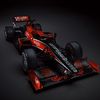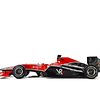Analysis: Virgin VR-01 is reality

Virgin have today taken their car to the track for the first time after presenting it to the public on Wednesday. While the launch was delayed a bit and missed some of its intended glamor, the designer team is extremely proud of its child that was born in a computer chip.
Right off the start of its media campaign, Virgin made it no secret that Wirth Engineering was going to design the car completely with CFD utilities. The team believe it to be the most cost effective solution, and have proved in Le Mans that such an approach is now flawed beforehand.
With only so much time left to test the car before the start of the season, Wirth finally decided to build the car, and in the meantime already passed the necessary crash tests.
Looking beyond the attractive livery, the brand new VR-01 features a rather simple front wing. The front wing endplates are small and the front wing currently does not incorporate a system for the driver to modify the angle of attack of the upper element. The wing is likely to see more development as the run towards Bahrain continues, but for now it will have to do for their testing.
The nose cone follows the trend to copy the Red Bull V-nose concept (as well as the rounded underside) and also has a rather pointy tip, almost as low as on the Mercedes GP (albeit longer). The front wheel suspension is mounted as a single keel system as the chassis has a tiny keel under its nose for the lower wishbone.
Rather unusual for the new cars are the front brake ducts. While most teams opt to position the ducts as high as possible, the VR-01 has them pointing downward, attempting to catch air from under the front wing. It is important to consider that in this area air is likely to be flowing faster and be marginally less dense.
The front of the sidepods then is clearly inspired by the Brawn BGP001 and is also rather similar to the 2010 McLaren. Small and high air inlets combined with a large undercut should provide for an efficient airflow around the sidepod, providing more potential downforce at the rear end.
Elaborate sidepod panels will surely help achieve this goal. In the middle this car looks very much developed at this moment, although it comes as a slight surprise that the mirrors are not mounted outboard, especially given the dimensions of the sidepod panels.
Just like with the new Ferrari, the sidepods are rather lean without sharp curves. In both cases, designers have chosen to build a long car to be able to position all components closer to the centre line. This Virgin, as well as the Ferrari are claimed to be approximately 5500 mm long, a massive 70 cm longer than the Mercedes GP car. While this may prove beneficial on fast circuits, the teams will likely face a stiff challenge at twisty road tracks.
The back end of the car looks to have some influence from last year's Red Bull as the sidepods' upper surface slope down rapidly, as well as the car's shoulders. While this puts the upper wishbone mounts completely in view, the suspension system is still a push rod design.








